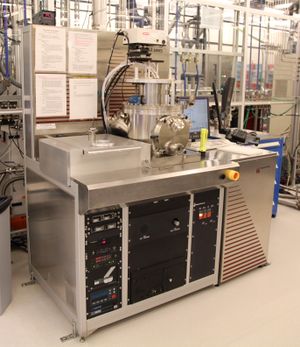Difference between revisions of "RIE 5 (PlasmaTherm)"
(Created page with "{{tool|{{PAGENAME}} |picture=RIE5.jpg |type = Dry Etch |super= Don Freeborn |phone= 805-893-3918x216 |location=Bay 2 |email=freeborn@ece.ucsb.edu |description = RIE #5 Programmab…") |
(added model to Tool panel) |
||
| (14 intermediate revisions by 6 users not shown) | |||
| Line 2: | Line 2: | ||
|picture=RIE5.jpg |
|picture=RIE5.jpg |
||
|type = Dry Etch |
|type = Dry Etch |
||
| − | |super= |
+ | |super= Brian Lingg |
| − | |phone= 805-893-3918x216 |
||
|location=Bay 2 |
|location=Bay 2 |
||
| − | |email=freeborn@ece.ucsb.edu |
||
|description = RIE #5 Programmable, Loadlocked Chlorine-Based System |
|description = RIE #5 Programmable, Loadlocked Chlorine-Based System |
||
|manufacturer = Plasmatherm (Unaxis) |
|manufacturer = Plasmatherm (Unaxis) |
||
| + | |model = SLT 770 |
||
|materials = |
|materials = |
||
| + | |toolid=27 |
||
}} |
}} |
||
| − | |||
= About = |
= About = |
||
| ⚫ | This computer-controlled, turbo-pumped RIE is the "work horse" of the processing laboratory due to it's ease of operation and versatility. It can be operated manually or in a fully programmable mode from sample loading to etching to sample unloading. Samples are placed on a silicon carrier with or without a bonding agent to facilitate sample cooling. Etching is done with oxygen or chlorine-based gases @ 13.56 Mhz. Oxygen is used for etching of photoresists and polyimide. Chlorine-based gases are used for etching semiconductors and some metals. Typical semiconductor materials that are etched are: AlGaAs, InGaAs, AlGaSb, GaN, and Si. Metals that can be etched include Al, Ti, and Cr layers. Good masking materials for the chlorine-based etching are photoresist (at powers < 200 W), Ni, SiO<sub>2</sub>, and SrF<sub>2</sub>. The wafer chuck can be heated to 80°C through liquid-based heating. This makes etching of high In-containing compounds difficult due to the non-volatility of In-chlorides. A high physical component (Ar in the mixture) is required for etching of InP and the surface will be contaminated with residual etch products when finished. |
||
| ⚫ | Special features include: a true sample loadlock, substrate backside helium cooling, heating up to 80°C, four inch sample holder, HeNe laser etch monitor and chart recorder. Various devices that use this tool as an integral processing step include: in-plane lasers, VCSELs, micro-lenses, Bragg-Fresnel lens, FETs, HBTs, etc. |
||
| ⚫ | This computer-controlled, turbo-pumped RIE is the "work horse" of the processing laboratory due to it's ease of operation and versatility. It can be operated manually or in a fully programmable mode from sample loading to etching to sample unloading. Samples are placed on a silicon carrier with or without a bonding agent to facilitate sample cooling. Etching is done with oxygen or chlorine-based gases @ 13.56 Mhz. Oxygen is used for etching of photoresists and polyimide. Chlorine-based gases are used for etching semiconductors and some metals. Typical semiconductor materials that are etched are: AlGaAs, InGaAs, AlGaSb, GaN, and Si. Metals that can be etched include Al, Ti, and |
||
| − | |||
| ⚫ | Special features include: a true sample loadlock, substrate backside helium cooling, heating up to 80°C, four inch sample holder, HeNe laser etch monitor and chart recorder. Various devices that use this tool as an integral processing step include: in-plane lasers, VCSELs, micro-lenses, Bragg-Fresnel lens, FETs, HBTs, etc. |
||
= Detailed Specifications = |
= Detailed Specifications = |
||
| Line 28: | Line 26: | ||
**100 W, constant power |
**100 W, constant power |
||
**60 nm / min. etch rate |
**60 nm / min. etch rate |
||
| + | |||
| + | =Documentation= |
||
| + | *[[RIE5 - Standard Operating procedure (Cortex Software)|RIE#5: Standard Operating Procedure (Cortex Software)]] |
||
| + | *{{file|How to restart the software on RIE.pdf|How to restart the software on RIE #5}} |
||
Revision as of 19:40, 10 February 2020
| |||||||||||||||||||||||
About
This computer-controlled, turbo-pumped RIE is the "work horse" of the processing laboratory due to it's ease of operation and versatility. It can be operated manually or in a fully programmable mode from sample loading to etching to sample unloading. Samples are placed on a silicon carrier with or without a bonding agent to facilitate sample cooling. Etching is done with oxygen or chlorine-based gases @ 13.56 Mhz. Oxygen is used for etching of photoresists and polyimide. Chlorine-based gases are used for etching semiconductors and some metals. Typical semiconductor materials that are etched are: AlGaAs, InGaAs, AlGaSb, GaN, and Si. Metals that can be etched include Al, Ti, and Cr layers. Good masking materials for the chlorine-based etching are photoresist (at powers < 200 W), Ni, SiO2, and SrF2. The wafer chuck can be heated to 80°C through liquid-based heating. This makes etching of high In-containing compounds difficult due to the non-volatility of In-chlorides. A high physical component (Ar in the mixture) is required for etching of InP and the surface will be contaminated with residual etch products when finished.
Special features include: a true sample loadlock, substrate backside helium cooling, heating up to 80°C, four inch sample holder, HeNe laser etch monitor and chart recorder. Various devices that use this tool as an integral processing step include: in-plane lasers, VCSELs, micro-lenses, Bragg-Fresnel lens, FETs, HBTs, etc.
Detailed Specifications
- Etch gases include: Cl2, BCl3, SiCl4, O2, Ar
- Full computer control or manual computer control
- Low 1 E-7 ultimate chamber pressure
- 13.56 Mhz excitation frequency
- Sample chuck He-backside cooled / heated (up to 80°C)
- Typical etch conditions for GaAs:
- 10 mT (15 sccm BCl3 / 10 sccm SiCl4)
- 100 W, constant power
- 60 nm / min. etch rate
